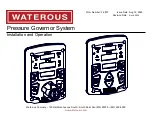
3
Adequate rinsing with physiological saline, as described in the
Technique section, is mandatory before implantation to reduce
the glutaraldehyde concentration. No other solutions, drugs,
chemicals, antibiotics, etc., should ever be added to the
glutaraldehyde or rinse solutions, as irreparable damage to the
leaflet tissue, which may not be apparent under visual
inspection, may result.
5. Precautions
•
The outside of the jar is not sterile and must not be placed
in the sterile field.
•
Adequate rinsing with physiological saline must be performed
before implantation to reduce the glutaraldehyde concentration.
•
Adequate removal of calcium deposits from the patient’s
annulus must be performed before implantation to avoid
damage to the delicate prosthetic valve leaflet tissue as a
result of contact with calcium deposits.
•
Glutaraldehyde may cause irritation of the skin, eyes, nose, and
throat, and may also cause skin sensitization. Avoid prolonged
or repeated contact or prolonged breathing of the solution. Use
only with adequate ventilation. In the event of contact,
immediately flush the affected area with water. In the event of
contact with the eyes, seek medical attention. For more
information about glutaraldehyde exposure please refer to
Material Safety Data Sheet available from Edwards Lifesciences.
•
The Magna bioprosthesis has a unique configuration
designed to fit above the patient annulus or within the
annulus. The surgeon should be familiar with the
recommendations for proper sizing and placement in the
supra-annular or intra-annular position. Refer to the Device
Implantation section (11.3) for further details.
•
Handle the prosthesis with only Edwards Lifesciences
accessories. Only Edwards Lifesciences sizers should be
used during the selection of the valve size; other sizers may
result in improper valve selection.
•
When choosing a valve for a given patient, the size, age, and
physical condition of the patient in relation to the size of the
prosthesis must be taken into consideration to minimize the
possibility of obtaining a suboptimal hemodynamic result.
The selection of a valve, however, must ultimately be made
by the physician on an individual basis after carefully
weighing all of the risks and benefits to the patient.
•
Due to the relative flexibility of the frame,
care must be
exercised to prevent folding or deformation of the stent
that
may lead to regurgitation, altered hemodynamics, and/or
leaflet disruption rendering the valve incompetent. In this
regard oversizing must be avoided.
•
The spacing of the sutures in the remnant of the valvular orifice
and the prosthesis suture ring must be carefully matched to
avoid folding of the leaflets or distortion of the orifice. Edwards
Lifesciences has received reports in which individual mattress
sutures, spanning a distance of 10 to 15 mm, produced a
pursestring effect causing compression of the valve orifice.
•
When using interrupted sutures, it is important to cut the
sutures close to the knots and to ensure that exposed
suture tails will not come into contact with the leaflet tissue.
Cases have been reported in which bioprostheses
developed severe regurgitation and had to be replaced as a
result of wear due to contact with sutures (Ref. 2).
•
Unlike rigid mechanical valves, the stent wall is soft and will
not resist needle penetration. Accordingly, extreme care
must be exercised when placing sutures through the sewing
margin to avoid penetration of the side wall of the stent and
possible laceration of the leaflet tissue.
•
As with all prostheses that have open cages, free struts, or
commissure supports, care must be exercised to avoid
looping or catching a suture around the commissure, which
would interfere with proper valvular function.
•
The stent of the aortic bioprosthesis is symmetrical, and the
commissure supports (struts) are equally spaced. The
struts should correspond to the remnants of the natural
commissures so as not to obstruct the coronary ostia.
•
A serial number tag is attached to the sewing ring of each
valve by a suture. This serial number should be checked
against the number on the jar and implantation data card; if
any difference is noted, the valve should be returned
unused. This tag should not be detached from the valve
until implant is imminent. Care should be exercised to avoid
cutting or tearing the suture ring cloth during removal.
•
Gentle handling is required for all implantable devices. If the
valve is dropped, damaged, or mishandled in any way, it
must not be used for human implantation.
•
Based on reports in the literature on tissue valves (Refs. 3, 18,
23, 26, 48, 49, & 54), there appears to be increased incidence
of leaflet calcification in patients under the age of 20. When
feasible, repeated intravenous injections containing calcium
should be avoided during the postoperative periods, and
excessive milk or dairy product consumption should be
avoided in children. Animal research studies (Ref. 11) show
that a high systemic calcium level can lead to early calcification.
6. Adverse Events
6.1 Observed Adverse Events
As with all prosthetic heart valves, serious adverse events,
sometimes leading to death, may be associated with the use of
tissue valves. In addition, adverse events due to individual patient
reaction to an implanted device, or to physical or chemical
changes in the components, particularly those of biological origin,
may occur at varying intervals (hours or days), necessitating
reoperation and replacement of the prosthetic device.
Adverse events associated with the use of Carpentier-Edwards
PERIMOUNT pericardial bioprostheses compiled from the
literature and from reports received through the product
surveillance system in accordance with the United States
(Federal) regulations establishing Good Manufacturing
Practices, section 820.198, include stenosis, regurgitation
through an incompetent valve, perivalvular leak, endocarditis,
hemolysis, thromboembolism, thrombotic obstruction, bleeding
149256001A_EN_ES_PT 16.2.2005 14:30 Uhr Seite 3



































